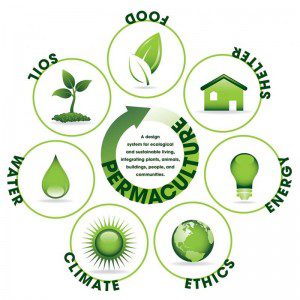Guest Writer for Wake Up World
The term permaculture hasn’t been around long: only since the 1970’s, but at its basis is a way of life that was the original order of the very first farming communities. Early farmers used only those seeds, plants, and elements that were indigenous to the immediate area in which they lived to create their farmable areas.
So, although, the term is new, permaculture’s roots are very old. What makes permaculture so cutting edge is the incorporation of new technologies and ecological research that make for landscape systems that are energy efficient, that cycle nutrients and resources, that use a diversity of plant life, and that are aware of the best use of design system’s margins as they flow into the existing terrain.
[pro_ad_display_adzone id=”110028″]
Permaculture is a contraction of the two words “permanent” and “agriculture” and now includes a philosophy that also means “permanent culture” as the social aspects of permaculture are both influences and effects of the idea. The new way of eco-gardening seeks to sustain and work with nature to harmonize natural elements in the environment with the people it serves. Permanent agriculture is a movement that is gathering momentum in communities all over the globe.
To incorporate the principles of permaculture means to utilize diverse elements that are present in the natural surroundings. It means that the new gardeners, permaculturists aim to: use each element in a way that nourishes and encourages other elements, that they incorporate plant life and eco-systems that are self-sustaining and produce no waste, that they design from patterns present in nature’s own motifs, and that they exercise ethical considerations in their designs.
A permacultural system seeks to:
- Minimize the amount of labor required.
- Utilize waste and turn it into a resource, such as composting.
- Create stable and bountiful systems that provide for humans — optimizing plants, animals and climate and their cycles– integrating these into an interdependent design.
Far from being old school in its approach, permaculturists carefully observe natural settings, indigenous plant life, features of the environment, and the people that these permanent, natural installations will serve. Permaculturists aim to create livable, sustainable environments. Features like edible landscapes are becoming commonplace as replacements for traditional flower gardens. Perennial plants such as ornamental berries, peppers and even edible flowers are appearing where floral annuals held sway for generations.
Permaculture also aims to capture energy, and store it. For instance, rock formations, when optimally utilized can store passive solar energy, providing warmth for natural greenhouses or even to help warm the people that live inside adjacent homes. The new permacultural landscapes are fluid and creatively respond to the changing needs and climes they exist to serve.
The watchwords of the new order of Permaculture are respect for the earth, caring for people and ethical boundaries regarding utilization of resources, offering any surplus yield for redistribution in the larger community.
About the Author
Kathleen Blakeslee received her Bachelor of Science in Design from the University of Minnesota in 1980 and worked on her Master’s studies in Ethno-Botany at the University of Wisconsin in 1982 along with being a licensed Holistic Nutrition Coach and has recently earned her degree in Permaculture Design at OAEC in Sebastopol, California and is the Founder of the Institute of Conscious Choice.
Through the years Kathy has accumulated a formative array of experiences. She is a master gardener, licensed nurseryman, herbalist, horticulture teacher, is an Eco Activist, she is the voice of social change.
[pro_ad_display_adzone id=”110027″]







